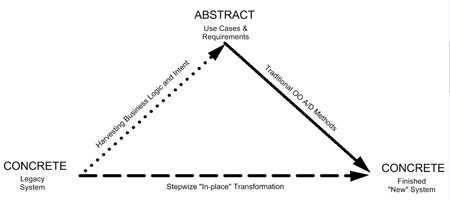The Transformation Triangle
 Transformation Triangle: For use in Transformation Triangle page
Transformation Triangle: For use in Transformation Triangle page
Development that follows traditional Object-Oriented Analysis & Design (OOAD) methodologies begins with tools such as Use Cases and Requirements specifications, which are very abstracted from the target software. Through a series of steps, some of which may be automated transformations, these abstract elements are gradually converted into more and more concrete model forms, which are closer and closer to the target software that is the focus of the development effort. In particular, using the techniques of Model-Driven Architecture (MDA), models are transformed from Computationally Independent Models (CIM) to Platform Independent Models (PIM) to Platform Specific Models (PSM). For example, the PIM might be a model which fully specifies the target software, but without a User Interface, and the PSM resulting from one stage of the transformation would then have a specific User Interface applied to that model. The transition of PIMPSM can occur multiple times, with the PSM from one step providing the PIM of the next step. Thus, the notions of Independent and Specific are relative to the context.
While this general approach can be highly successful for developing new systems, when considering the transformation of an existing legacy system one has a somewhat different problem. In this case the concrete, “finished” system already exists, but something about it is “wrong”. It might use an outdated technology, an old user interface technology or style, or have a monolithic architecture, which is not as well suited as service-oriented architectures for nimble response to changing business conditions. Whatever its flaw or flaws, the desire for transformation indicates that there is a need for substantial change in the application, far beyond the day to day maintenance, modifications, and small new features which are typical of mature applications.
Download paper to keep reading or look at remaining pages below.
| Attachment | Size |
|---|---|
| TransformationTriangle.pdf | 86.85 KB |
- Printer-friendly version
- Login to post comments
